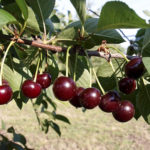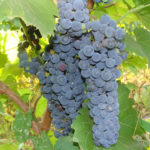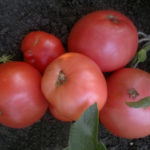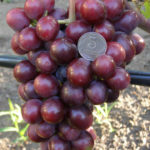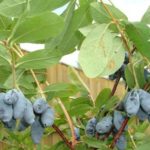Rose Burgund 81 (Burgund 81)
Tea hybrids with flowers of red shades are worthy of taking pride of place in the garden of any grower. They have unsurpassed beauty and are, in a way, a symbol of the classic style that does not become obsolete over time. It is easy to be convinced of this by getting acquainted with the variety of roses Burgundy 81.
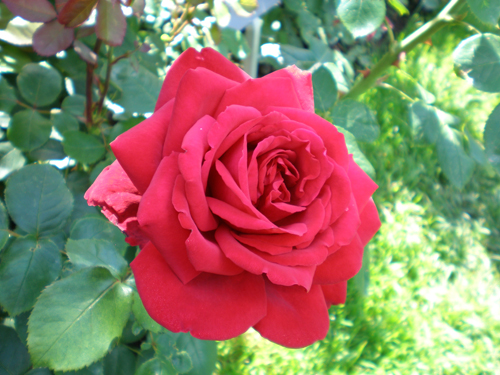
History of origin
The culture with the aristocratic name Burgund 81 appeared in Germany, in the Kordes Rosen nursery. The variety was bred by the breeders of the famous company back in the break of the century, namely in 1981. The plant has several synonymous names: The Macarthur Rose, Red Cedar, Loving Memory. The working name of the decorative perennial is KORgund81. The name under which the variety became known to the whole world, the shrub received in honor of the Germanic Burgundian tribe who lived
Description of the variety
The rose grows in the form of a dense bush with straight, strong shoots, covered with a moderate number of thorns and dark green, leathery, glossy leaves of large size. Young foliage has a reddish brown tint. Perennial is prone to branching. In height, it reaches 110-120 cm, maximum - 1.5 meters. The crown diameter of the plant is approximately 80 cm.
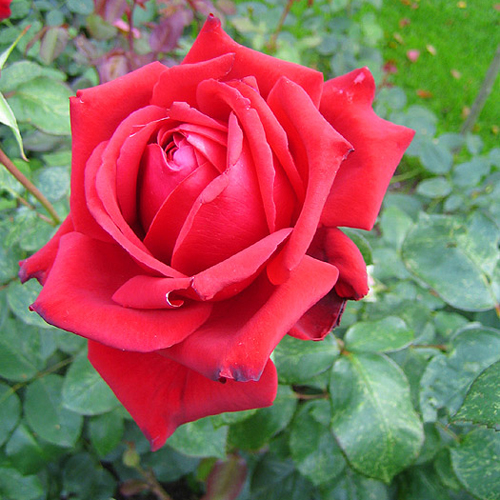
On the stems of Burgund 81, single buds are formed, which stand out against the background of fir-green foliage with a dark red, almost black color and an amazing conical shape. As it unfolds, the pointed outer petals curl around the edges, revealing the central part of the flower to prying eyes. However, even in the phase of complete dissolution, the middle of the bud with stamens remains invisible, but the flower itself loses its shape and looks like a chaotic mass of petals.
The flowers of the hybrid tea rose are large (at least 10 cm in diameter), double and rather fragrant. Their fragrance can be guessed with the presence of chocolate accords, playful aroma of champagne and fruity notes. They consist of 30-35 velvety dark red-crimson petals. True, the core of the flower is sustained in lighter colors. Burgundy 81 blooms profusely and for a very long time: from the end of June until the very autumn frosts.
This perennial has many advantages over other varieties of hybrid tea roses. Firstly, its stems are highly resistant to strong gusts of wind, without being damaged under the onslaught of the elements. Secondly, the flowers of the plant are little afraid of rain and do not fade at all in the sun. Thirdly, the variety is distinguished by good immunity to diseases. One thing is bad: perennial winter hardiness is not too high. The shoots of the rose bush freeze out even at air temperatures below -23ºC. However, a reliable shelter for the winter will fix this.
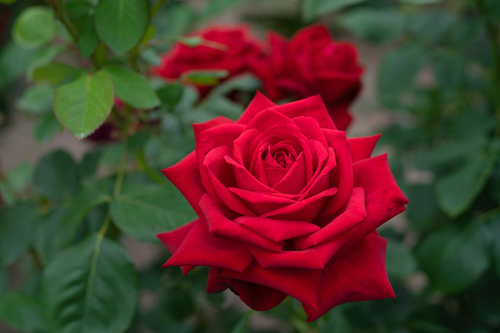
Agrotechnical features
The landing site for Burgund 81 should be moderately sunny. The shrub will also feel good in partial shade. It is best to place the crop on slopes or a flat area, since in the lowlands, stagnant water will provoke the development of black spot culture on the leaves, and also increase the risk of root decay. The rose needs a fertile soil, with a sufficient degree of air and water permeability. Swampy soils, like dry soils, are unacceptable for growing shrubs. The lightness, looseness of the substrate is also very important, for this reason, a high-quality drainage layer is required at the bottom of the planting pit: gravel, fine gravel and sand. And the soil must have a slightly acidic reaction. This is not difficult to achieve: if the soil you are using is too acidic, add lime earth or wood ash to it, and to increase the acidity, add humus, peat or fresh manure to the substrate.
In order for Burgundy 81 to please you with a large number of beautiful flowers, you need to take good care of it throughout the summer season: water, feed, spray with insecticide and fungicide solutions to prevent pests and diseases. In addition, you will need to regularly loosen the soil under the crop, fill it with mulch, and remove weeds around the rose. In the spring, it is required to perform sanitary pruning, during which it is necessary to remove all frozen, dry, damaged and too thin shoots on the bush. In the fall, similar manipulations are performed with the only difference that the strong stems are also shortened, so that after that the plant can be covered for the winter. True, the bush is previously hilled with dry soil, humus or peat.
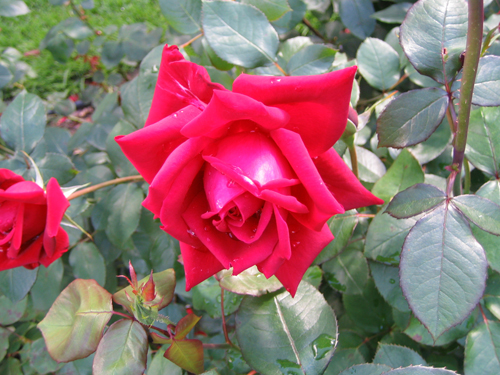
It is worth talking in more detail about watering and feeding the tea hybrid. Our hero is very sensitive to poor-quality water, so it is recommended to moisten the soil under him only with settled, clean moisture, slightly warmed up in the sun. Cold and hard water is absolutely not suitable for irrigation of this variety. As for dressing, in the spring the rose needs organic fertilizers that can help the culture to grow green mass; in summer, the use of a specialized mineral complex is shown, which can be purchased at the store. The main thing is that potassium, calcium and phosphorus must be present in the composition of such a concentrate, among other nutrients.
Use cases
Variety Burgundy 81 opens up almost endless possibilities for its owner for decorating a garden or flower garden. It looks gorgeous in groups and as a specimen plant against a bright green grassy lawn. A decorative perennial can be planted in the foreground of the site, or along the facade of the house, where it will attract admiring glances. Noble roses of this variety are also suitable for decorating hedges.
Burgund 81 goes well with crops that have snow-white, bright and light yellow, scarlet or pale pink inflorescences. Good companions for him will be:
- Japanese irises, pleasing to the eye not only with beautiful flowering, but also with a juicy shade of green foliage;
- daylilies with elongated flowers;
- Asiatic, curly and tubular lilies;
- cultures with openwork inflorescences (basil, asparagus, gypsophila paniculata, yarrow ptarmica, burnet).
A successful combination of Burgundy 81 variety with rudbeckia, phlox, coreopsis, salvia, astilba, reed grass, Chinese miscanthus, virginian physicalostegia, phytollac, sedum, primrose, decorative onions, mordovia, catnip, thyme, yarrow. You will get an interesting contrast by placing next to the noble beauty Keronikastrum, Solidaster, Euphorbia, yellow-leaved varieties of Hosta and Heuchera or barberry. The classic is the neighborhood of a lovely German woman and coniferous cultures.
Fragrant rose flowers are often used in cutting. Standing in a vase of water, they retain their attractive appearance for a long time without crumbling.
